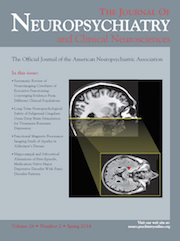Delirium After Transdermal Scopolamine Patch in Two Children
To the Editor: Scopolamine, also known as hyoscine, is a selective muscarinic antagonist. Transdermal scopolamine patch (TDSP) is an effective, safe, and convenient method to deliver the drug to reduce symptoms such as postoperative nausea and vomiting (PONV) and motion sickness.1 TDSP is widely used in adults and most of the adverse effects are mild. Although, its use in children is not approved, off-label use is not uncommon due to its ready availability. We report two cases of delirium in young boys after TDSP use, focusing on the lack of safety warning from the manufacturer and the need for emergency department personnel to be alert to the possibility of drug-related acute psychosis.
Case Report
Two brothers, aged 4 and 6, presented to the emergency department with abrupt onset of cognitive confusion, visual hallucinations, and incoherent speech. There was no history of fever, trauma, vomiting, dry mouth, urinary retention, or substance use, except for a 1.5-mg TDSP (Charng Shing Co., Ltd., Taipei City, Taiwan) present behind each child’s ear 22 hours prior to admission to prevent motion sickness on a long-distance journey. Upon arrival, the vital signs were stable except for mild tachycardia, with a pulse rate of 100/minute. Electrocardiography showed sinus tachycardia without ischemic changes and blood chemistry studies were unremarkable. Children were agitated, hyper-talkative, and appeared to be hallucinating. Physical examination revealed mildly dilated pupils with a normal light reflex. No other neurologic abnormality was found. Acute delirium caused by TDSP was suspected. TDSPs were removed, and the patients were kept under observation in the emergency department. Six hours after removal of the patch, their delirium persisted and they became more agitated. After complete neurological evaluation, physostigmine (0.02 mg/kg) was intramuscularly administered and the patients were closely monitored. Their delirium improved and there were no signs of cholinergic crisis such as hypotension or dysrhythmia. Eighteen hours after physostigmine administration, they were discharged with complete resolution of the neurological and psychological abnormalities. Both patients were followed up after 1 month.
Discussion
Delirium is a neuropsychiatric disorder with various causes and protean manifestations. Any organic or psychological disorder may present with delirium, and the differential diagnosis remains a challenge to physicians. Diagnosis of delirium in children is more difficult and may be easily missed; thus, obtaining a detailed history may provide a diagnostic clue, as in the present patients.2
TDSP is effective in reducing PONV and motion sickness. Each patch contains 1.5 mg of scopolamine and is formulated to deliver the drug at a constant rate over a 3-day period.3 The unique design makes it convenient and safe when used in adults. The use of TDSP in the adult population was approved by the Food and Drug Administration in the United States in 2001, and most of its adverse effects are mild, including dry mouth, drowsiness, and allergic contact dermatitis. TDSP is not approved in children younger than 12 years old, and studies of TDSP use in the pediatric population are limited. In two studies of children following surgery, TDSP was found to be safe and effective.4,5 However, the total amount of scopolamine in the patch was reduced to 0.25∼0.75 mg. Because of the special design of currently available commercial TDSPs, cutting the patch to a smaller size is not suggested. Further studies are needed to determine the pharmacokinetics in the pediatric population to determine an appropriate dose in children. In Taiwan, TDSPs are readily available in pharmacies without a prescription. Off-label use is common, and the risks of using an adult-dose patch in children should be clearly stated in the package directions and drug safety in children is reinforced.
Often, patients with scopolamine overdose can be treated by removal of the patch and supportive care. Physostigmine, a reversible cholinesterase inhibitor, crosses the blood–brain barrier and can be used to treat scopolamine intoxication. Because of its association with cholinergic crisis and its short half-life, it is reserved for patients with serious anticholinergic-induced agitation, delirium, and hallucinations, and must be administered under direct monitoring. In addition, it may serve as a diagnostic agent; improvement in anticholinergic symptoms after its administration suggests anticholinergic syndrome.
In conclusion, TDSP has been in use for 1 decade and is safe and convenient in adults. However, the use of TDSP may cause delirium and visual hallucinations in children and should be avoided in patients younger than 12 years old. Detailed history-taking often elucidates the etiology of delirium, and physostigmine testing under monitoring may simultaneously diagnose and treat scopolamine overdose.
1 : Scopolamine (hyoscine) for preventing and treating motion sickness. Cochrane Database Syst Rev 2011; 6:CD002851Medline, Google Scholar
2 : Delirium in children and adolescents. J Neuropsychiatry Clin Neurosci 2003; 15:431–435Link, Google Scholar
3 : Transdermal scopolamine for prevention of motion sickness: clinical pharmacokinetics and therapeutic applications. Clin Pharmacokinet 2006; 45:543–566Crossref, Medline, Google Scholar
4 : Scopolamine patch reduces postoperative emesis in paediatric patients following strabismus surgery. Can J Anaesth 1991; 38:441–444Crossref, Medline, Google Scholar
5 : Effect of transdermal hyoscine on nausea and vomiting after surgical correction of prominent ears under general anaesthesia. Br J Anaesth 1995; 74:647–650Crossref, Medline, Google Scholar



